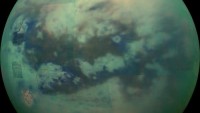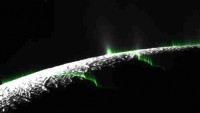Saturn's Moons Pose For An Incredible Cosmic Bull's Eye
| Ana Verayo | | Dec 16, 2015 09:54 AM EST |
(Photo : NASA/JPL-Caltech/Space Science Institute) Saturn's moons, Enceladus and Tethys line up almost perfectly for Cassini's cameras.
NASA's Cassini spacecraft captured one of the most stunning images of Saturn and two of its moons where the probe has been travelling around the majestic ringed system for already more than a decade.
This latest image is a high resolution photograph of Saturn's moon Enceladus and Tethys, which are the more well known moons, in an uncanny near perfect alignment. Enceladus, which is the smaller moon, appears to be the bull's eye in this extremely rare moment.
Like Us on Facebook
The two natural satellites' similar distances were captured by the Cassini spacecraft in this image that allowed observers to compare the sizes Enceladus and Tethys. Enceladus is measured at 313 miles in diameter and the bigger moon Tethys looms over at 660 miles wide.
This moon transit was captured last September 24, where the Cassini probe was located at a distance of 1.3 millions miles from Enceladus and some 1.6 million miles from Tethys. This would indicate that the two moons would be just 300,000 miles away from each other.
The Cassini space mission is done in collaboration with the Italian Space Agency, the European Space Agency and NASA. The Cassini probe is also managed by NASA's Jet Propulsion Laboratory and California Institute of Technology (Caltech) in Pasadena, California.
NASA's JPL is also responsible for developing and building the Cassini orbiter including the two onboard cameras of the spacecraft. The images are beamed back to Earth and processed by the Space Science Institute's imaging operations center.
To date, mission scientists are closely monitoring Enceladus since past data from Cassini suggest that the moon could possibly possess a global ocean underneath its icy crust. This massive body of water can also hold clues about life giving elements as well.
On December 19, the Cassini spacecraft will conduct its final flyby of Enceladus where it will become the probe's 22nd one, that will spiral down within 3,106 miles of the surface of the moon.
TagsNASA Cassini probe, saturn moons, saturn moon enceladus tethys, enceladus moon, tethys moon, Saturn, image saturn moons
©2015 Chinatopix All rights reserved. Do not reproduce without permission
EDITOR'S PICKS
-

Did the Trump administration just announce plans for a trade war with ‘hostile’ China and Russia?
-

US Senate passes Taiwan travel bill slammed by China
-

As Yan Sihong’s family grieves, here are other Chinese students who went missing abroad. Some have never been found
-

Beijing blasts Western critics who ‘smear China’ with the term sharp power
-

China Envoy Seeks to Defuse Tensions With U.S. as a Trade War Brews
-

Singapore's Deputy PM Provides Bitcoin Vote of Confidence Amid China's Blanket Bans
-

China warns investors over risks in overseas virtual currency trading
-

Chinese government most trustworthy: survey
-

Kashima Antlers On Course For Back-To-Back Titles
MOST POPULAR
LATEST NEWS
Zhou Yongkang: China's Former Security Chief Sentenced to Life in Prison

China's former Chief of the Ministry of Public Security, Zhou Yongkang, has been given a life sentence after he was found guilty of abusing his office, bribery and deliberately ... Full Article
TRENDING STORY

China Pork Prices Expected to Stabilize As The Supplies Recover

Elephone P9000 Smartphone is now on Sale on Amazon India

There's a Big Chance Cliffhangers Won't Still Be Resolved When Grey's Anatomy Season 13 Returns

Supreme Court Ruled on Samsung vs Apple Dispute for Patent Infringement

Microsoft Surface Pro 5 Rumors and Release Date: What is the Latest?













